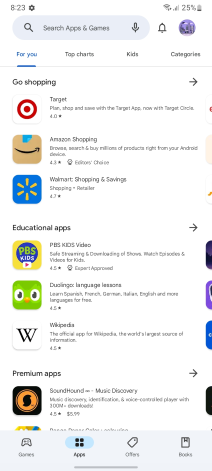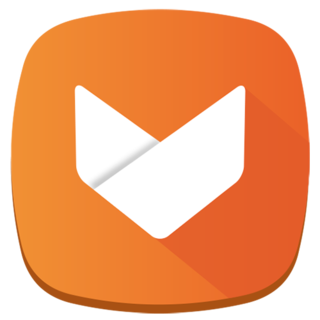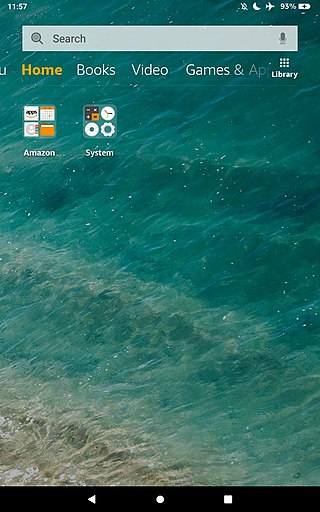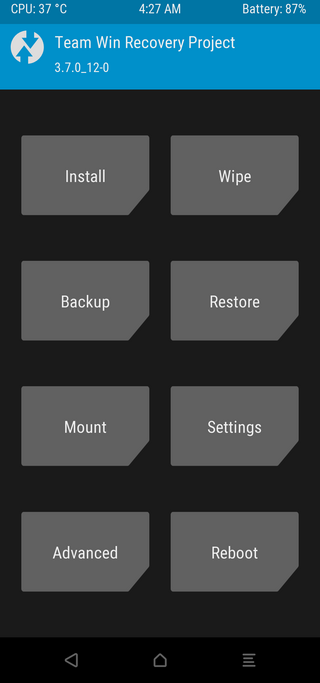Android is a mobile operating system based on a modified version of the Linux kernel and other open-source software, designed primarily for touchscreen mobile devices such as smartphones and tablets. Android is developed by a consortium of developers known as the Open Handset Alliance, though its most widely used version is primarily developed by Google. It was unveiled in November 2007, with the first commercial Android device, the HTC Dream, being launched in September 2008.
The Android Package with the file extension apk is the file format used by the Android operating system, and a number of other Android-based operating systems for distribution and installation of mobile apps, mobile games and middleware. A file using this format can be built from source code written in either Java or Kotlin.
Rooting is the process by which users of Android devices can attain privileged control over various subsystems of the device, usually smartphones. Because Android is based on a modified version of the Linux kernel, rooting an Android device gives similar access to administrative (superuser) permissions as on Linux or any other Unix-like operating system such as FreeBSD or macOS.

Amazon Appstore is an app store for Android-compatible platforms operated by Amazon.com Services, LLC, a subsidiary of Amazon.

The Android Debug Bridge is a programming tool used for the debugging of Android-based devices. The daemon on the Android device connects with the server on the host PC over USB or TCP, which connects to the client that is used by the end-user over TCP. Made available as open-source software under the Apache License by Google since 2007, features include a shell and the possibility to make backups. The adb software is compatible with Windows, Linux and macOS. It has been misused by botnets and other malware, for which mitigations were developed such as RSA authentication and device whitelisting.

Google Play, also known as the Google Play Store or Play Store and formerly Android Market, is a digital distribution service operated and developed by Google. It serves as the official app store for certified devices running on the Android operating system and its derivatives, as well as ChromeOS, allowing users to browse and download applications developed with the Android software development kit (SDK) and published through Google. Google Play has also served as a digital media store, offering games, music, books, movies, and television programs. Content that has been purchased on Google Play Movies & TV and Google Play Books can be accessed on a web browser and through the Android and iOS apps.

ClockworkMod is a software company, owned by Koushik "Koush" Dutta, which develops various software products for Android smartphones and tablets. The company is primarily known for its custom recovery image, ClockworkMod Recovery, which is used in many custom ROMs.

Aptoide is an online marketplace for mobile applications which runs on the Android operating system. In Aptoide, unlike the Android-default Play Store, there is not a unique and centralized store; instead, each user manages their own store. The software package is published by Aptoide S.A., a for-profit company incorporated in 2011, and headquartered in Lisbon, Portugal.
Samsung Knox is a proprietary security and management framework pre-installed on most Samsung mobile devices. Its primary purpose is to provide organizations with a toolset for managing work devices, such as employee mobile phones or interactive kiosks. Samsung Galaxy hardware, as well as software such as Secure Folder and Samsung Wallet, make use of the Knox framework.

Fire OS is a mobile operating system based on the Android Open Source Project (AOSP). It is developed by Amazon for their devices. Fire OS includes proprietary software, a customized user interface primarily centered on content consumption, and heavy ties to content available from Amazon's storefronts and services.

Team Win Recovery Project (TWRP), pronounced "twerp", is an open-source software custom recovery image for Android-based devices. It provides a touchscreen-enabled interface that allows users to install third-party firmware and back up the current system, functions usually not supported by stock recovery images. It is, therefore, often installed when flashing, installing, or rooting Android devices, although it does not require a device to be rooted before installation.

KingoRoot is software intended to provide root access on smartphones, tablet computers, etc. running all versions of the Android operating system from 4.1.2, available since 2013. There is another very similar Android Application with the same purpose, KingRoot launched at about the same time; the two very similarly-named applications are often confused.

Tasker is an Android application originally developed by a developer known as "Pent", and later purchased by João Dias. It enables performing user-defined actions based on contexts in user-defined profiles, activated by click- or timer-based home screen widgets. It is expandable via AutoApps plugins from the developer and third-party apps. The app is available from Google Play; a 7-day free trial version which does not allow restoring backups can be downloaded as an APK on the app's website.

LineageOS is an Android-based operating system for smartphones, tablet computers, and set-top boxes, with mostly free and open-source software. It is the successor to CyanogenMod, from which it was forked in December 2016, when Cyanogen Inc. announced it was discontinuing development and shut down the infrastructure behind the project. Since Cyanogen Inc. retained the rights to the Cyanogen name, the project rebranded its fork as LineageOS.

UserLAnd Technologies is a free and open-source compatibility layer mobile app that allows Linux distributions, computer programs, computer games and numerical computing programs to run on mobile devices without requiring a root account. UserLAnd also provides a program library of popular free and open-source Linux-based programs to which additional programs and different versions of programs can be added.

Huddles was an American short-form video hosting service and social network where users could create looping videos that are between 2–16 seconds long. It was created by a team led by Dom Hofmann as a successor to Vine, which Hofmann co-founded, until the project was sold to Clash App, Inc. and subsequently renamed.

The Android recovery mode is a mode of Android used for installing updates and wipe data. It consists of a Linux kernel with ramdisk on a separate partition from the main Android system.

Magisk is free and open-source software for the rooting of Android devices, developed by John Wu. Magisk supports devices running Android 6.0+.












